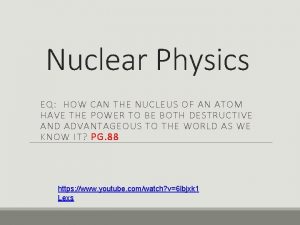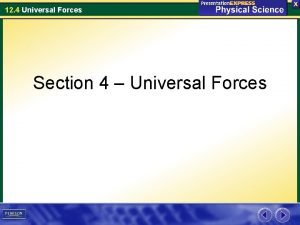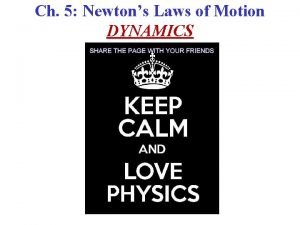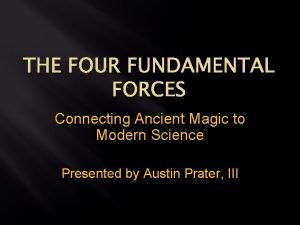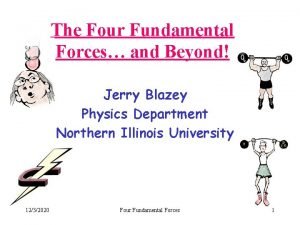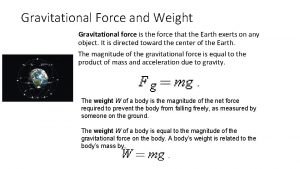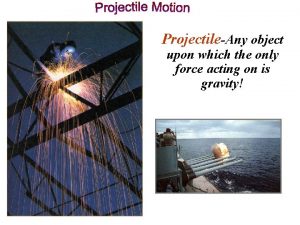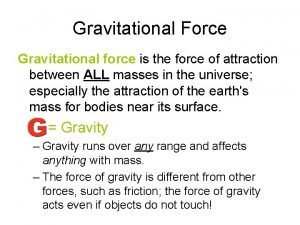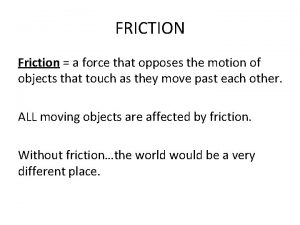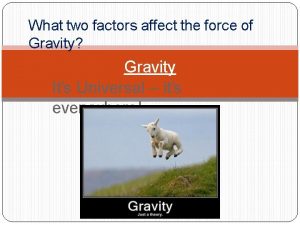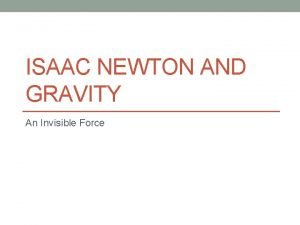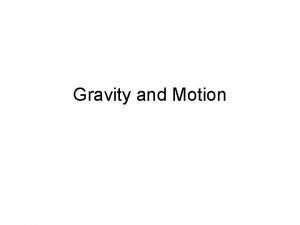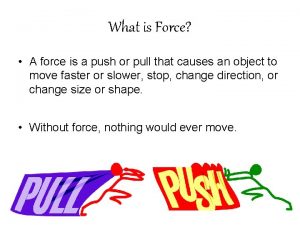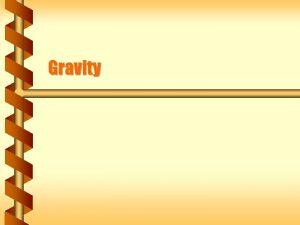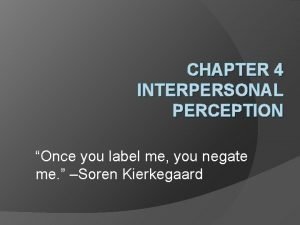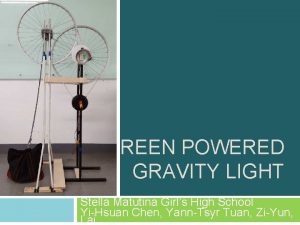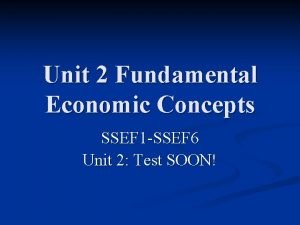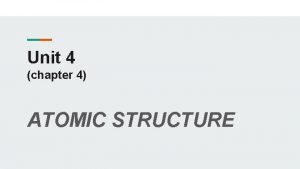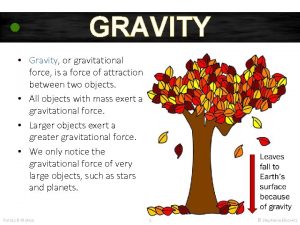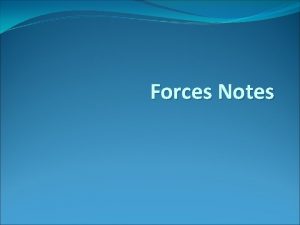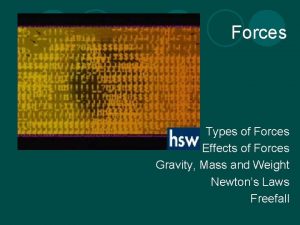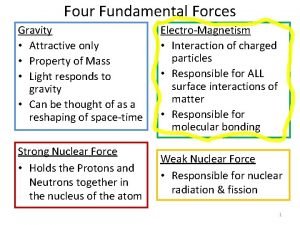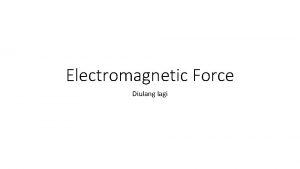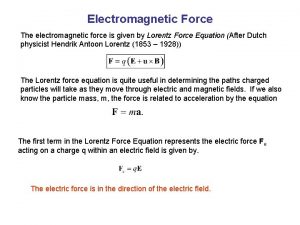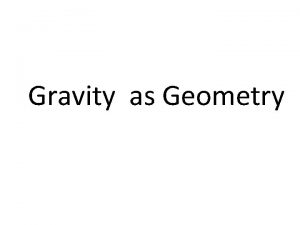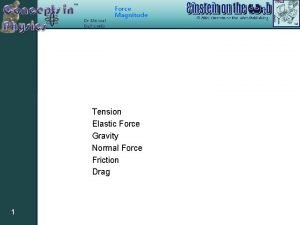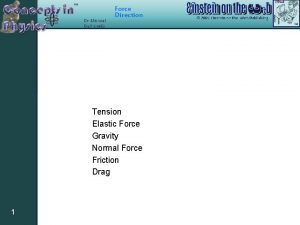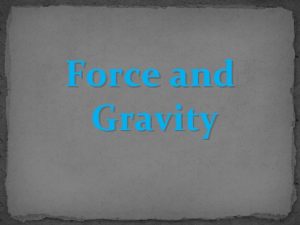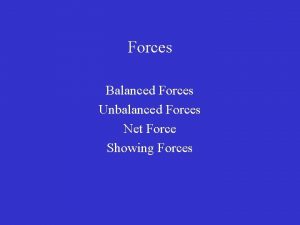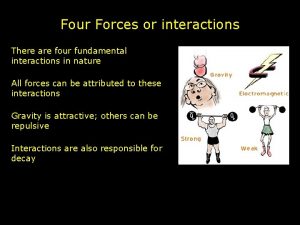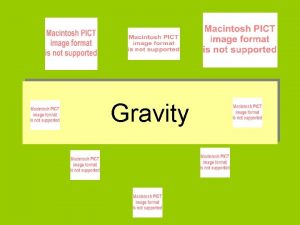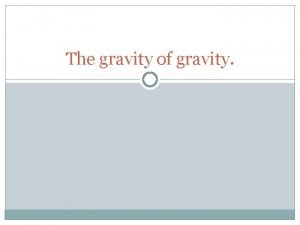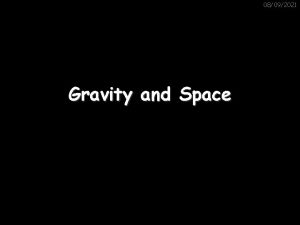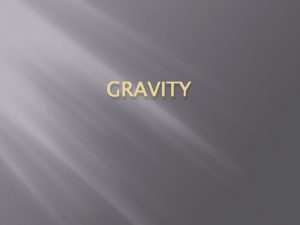Force Review Four Fundamental Forces Nature Gravity Electromagnetic







































- Slides: 39

Force Review

Four Fundamental Forces Nature • • Gravity Electromagnetic Strong Nuclear Weak Nuclear

Common forces • • • Gravity – weight, attraction between masses. Friction - surfaces, air/wind resistance Elastic/Strain/Tension – deformation of shape. Electric – attraction / repulsion charges q. Magnetic - attraction / repulsion magnetic poles. • Normal – reaction force perpendicular to surfaces.

Forces Review Newton’s 1 st Law (Inertia) • Balanced F = Equilibrium: Fnet = 0 constant v, or v = 0. • Translational Equilibrium – all F in all directions balanced. • Vertical equilibrium - upward & downward forces are balanced. • Horizontal equilibrium, left & right forces balanced. • Inertia is a property of matter directly proportional to mass. Measure of resistance to acceleration.

Fnet ≠ 0 (Newton 2) • Unbalanced forces cause acceleration in the direction of Fnet. • a = Fnet/m • acceleration rate change in velocity directly proportional to Fnet, inversely proportional to mass.

Newton 3: Action Reactions Pairs • F a, b = - F b, a. • IB - action/ reaction pairs. • IB: Normal Force Fn = Reaction Force, R.

Know Newton’s 3 laws of motion • Inertia • Acceleration a =Fnet/m • Action/Reaction – Forces in pairs. Fa, b = -F b, a.

Sketch Free Body Diagrams • Show all forces, (relative or scaled) magnitudes, directions acting on a body. Identifies direction/mag of Fnet. • No other arrows except forces.

Define • Translational Equilibrium: linear forces balanced • Balanced Forces – no linear acceleration.

Be able to: • Identify action/reaction pairs. • Solve problems in net force/ acceleration. • Remember Fnet = S Forces = ma. • Can write & state S Forces = ma = F 1 + F 2 + F 3…

Force Vectors • 1. The 25 -kg sign (Joe’s) is suspended by two cables: A and B. • Sketch a free body diagram. • Find the tension in each cable.

30 o. Ta. Tb. Fg = 250 N • Tb = 144 -N • Ta = 289 -N

Using Fnet = S F = ma • • • Inclined Plane. Elevator Horizontal Pulley Connected masses. Atwood’s machine.

Inclined Plane 2. The 5 -kg box above is pushed up a 20 o incline at constant speed. • Sketch the free body diagram. • Calculate the pushing force if m, the coefficient of friction is 0. 49. Remember Ff = m. Fn.

3. The box pictured below is accelerating down a 25 o incline at 1. 5 m/s 2. • • Sketch the free body diagram. Designate the downhill direction as positive. Write the equation of Fnet. Calculate m.

Elevator Forces Elevators. Scale measures normal force. Not weight.

Sketch free body on man in elevator. • Write the equation for Fnet. • Fnet = SF = F 1 + F 2 … ma = F 1 + F 2 …

4. A 100 kg man stands on a scale in an elevator. Use g = 10 m/s 2. • What will the scale read when the elevator: a. b. c. d. Goes up at constant velocity. Accelerates up at 2 m/s 2. Accelerates down at -3 m/s 2. Accelerates down at -10 m/s 2.

The scale reads the normal force. a) at constant velocity, a = 0 ma = 0 SF = 0 so 0 = Fn – mg mg = Fn – Fn ~ (100 kg) (10 m/s 2) 1000 N He feels the same

b) ma = Fn - mg for a =2 m/s 2. (100 kg)(2 m/s 2) + (1000 N) = 1200 N He feels heavier.

c) ma = Fn - mg (100 kg)(-3 m/s 2) + (100)(10 m/s 2) = 700 N He feels lighter.

• d) ma = Fn - mg • • ma + mg = Fn 100 kg (-10 + 10) m/s 2 Fn = 0 He feels weightless! He is in freefall.

Read Hamper 2. 2 Problems in Force #1 -4. • Problem Sheet “Problems in Force 2” Sketch all free body diagrams with that. • Do pg 29 #5, 6.

Linear Momentum Product mass x velocity Property of object moving in straight line p = m. Dv Vector quantity that is conserved. Don’t forget to include sign for velocity when calculating. • S pbefore = S pafter. • Impulse = Dp. Relates Force to momentum. • • •

Momentum Change & Newton’s 2 nd Law • F = ma • F = m. Dv Dt • FDt =m. Dv m (vf - vi) for const mass. • FDt = Dp Dp = Change in momentum

Force N force - t graph: Dp Impulse is area under curve For constant force = FDt.

Non-Constant Force vs. time graph. The area under the curve = impulse or Dp change in momentum.

Impulse involves time Work involves distance! Work = Fd cos q. The force must be parallel to the distance moved (0 o or 180 o)

Work: force x distance moved in direction of force. W = F cos q. For varying force = area under curve on F vs. d graph.

Work is a scalar measured in Joules. • Work done on an object causes changes in energy in by the amount of work done. • Ex: if 300 Joules of work is done stopping a moving object, 300 J of KE was converted to thermal E, and sound.

A grenade is launched into the air and explodes into hundreds of pieces at the top of its arc. How does the total KE and total momentum compare just before and just after the explosion? • KE • Momentum more, less, the same.

Positive & Negative Work • Work can be pos, 0, neg depending on q: If 0° ≤ q < 90° If a = 90° If cos q = + cos q = 0 90° < q ≤ 180° W is positive. W is 0. cos q is neg W is neg.

Types of Energy Mechanical • KE • PEg • PE elas Non- Mechanical • • • Heat Light Sound Nuclear Chemical Electro-magnetic.

Conservation of Energy • Holds true for all energy but – KE not conserved necessary…. E can be converted to other types. • Momentum is a single quantity. It must be conserved!! • To find final velocity don’t assume KE is conserved unless a collision is elastic.

We can relate KE to momentum • See text for derivation.

Power = rate work gets done/E transformed. The k. Wh is a unit of energy equivalent to 1 k. W of power expended for 1 h of time. Use 1000 watts for 1 hour, that's a kilowatt-hour. • k. Wh are units of energy. • 1000 J/s (1 h) (3600 s/h) = 3. 6 x 106 J

Efficiency is ratio of amount of work, Energy, power we get out compared to amount put in. • Often expressed as %.

Ex: A car engine has eff of 20% and produces 25 k. J of useful work/sec. How much energy is converted to heat per sec? •

Handout Power & Efficiency.
 Four fundamental forces of nature
Four fundamental forces of nature Universal forces
Universal forces Basic laws of dynamics
Basic laws of dynamics Four fundamental forces
Four fundamental forces Larry's four forces
Larry's four forces Four forces
Four forces Gravity for dummies and dummies for gravity equations
Gravity for dummies and dummies for gravity equations Equation of electromagnetism
Equation of electromagnetism Define electromagnetic force
Define electromagnetic force The only force acting on a projectile
The only force acting on a projectile Effect of gravitational force
Effect of gravitational force What force besides gravity acts on a projectile
What force besides gravity acts on a projectile Is tension a contact or noncontact force
Is tension a contact or noncontact force Which two factors affect gravity
Which two factors affect gravity Why is gravity a non contact force
Why is gravity a non contact force Is gravity invisible
Is gravity invisible How much is the force of gravity
How much is the force of gravity Non contact force
Non contact force Gravity force
Gravity force Gravity force
Gravity force Fundamental forces in interpersonal perception
Fundamental forces in interpersonal perception Stella matutina girls' high school
Stella matutina girls' high school Lesson 4 gravity and motion lesson review
Lesson 4 gravity and motion lesson review Nature of fundamental rights
Nature of fundamental rights Two unlike parallel forces
Two unlike parallel forces The forces shown above are
The forces shown above are Intermolecular forces vs intramolecular forces
Intermolecular forces vs intramolecular forces Similarities of intermolecular and intramolecular forces
Similarities of intermolecular and intramolecular forces Covalent bond intermolecular forces
Covalent bond intermolecular forces Contact force
Contact force Force examples in everyday life
Force examples in everyday life Constructive and destructive forces examples
Constructive and destructive forces examples Four fundamental operations
Four fundamental operations Four fundamental oop concepts
Four fundamental oop concepts The sacred seven
The sacred seven Ssef price list
Ssef price list Physics 102
Physics 102 4 forces of nature
4 forces of nature Nature and nature's law lay hid in night meaning
Nature and nature's law lay hid in night meaning Determinace lidské psychiky
Determinace lidské psychiky
